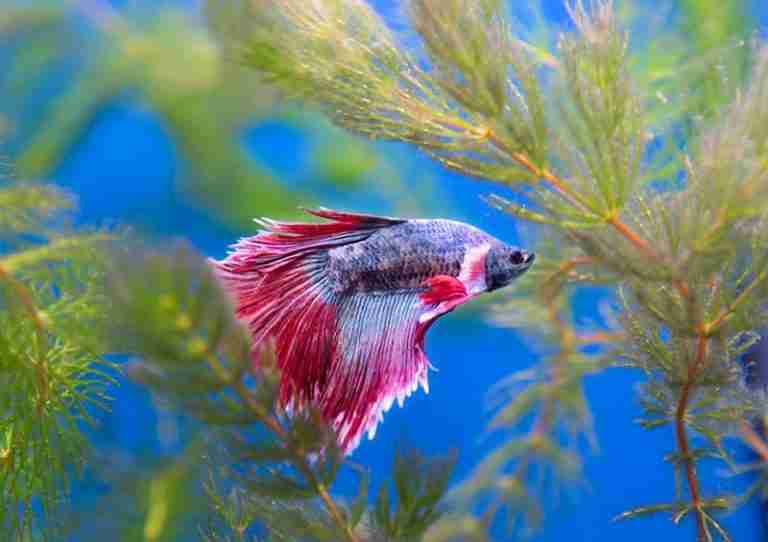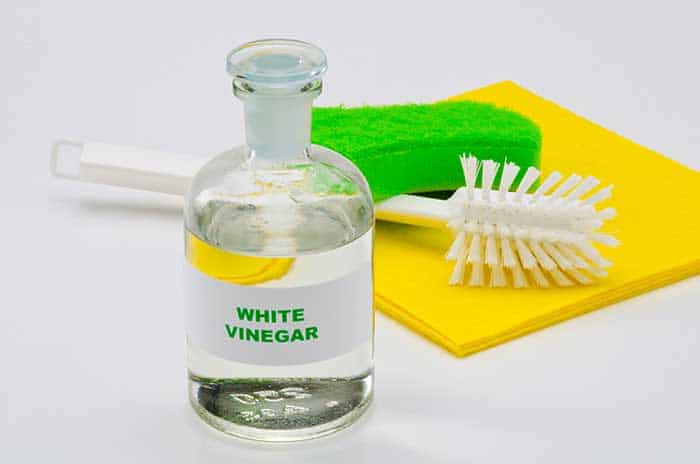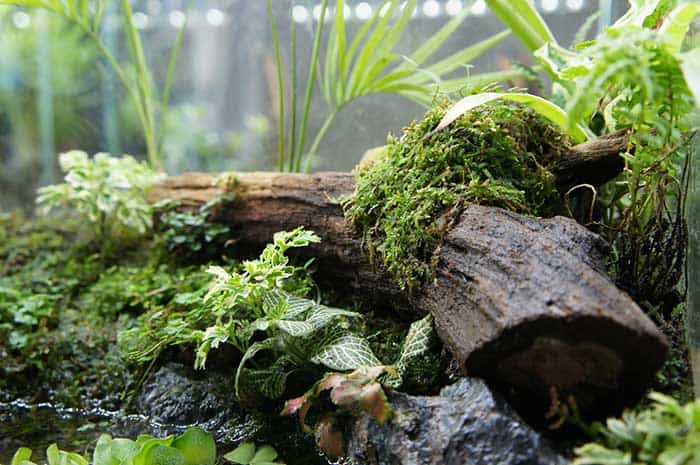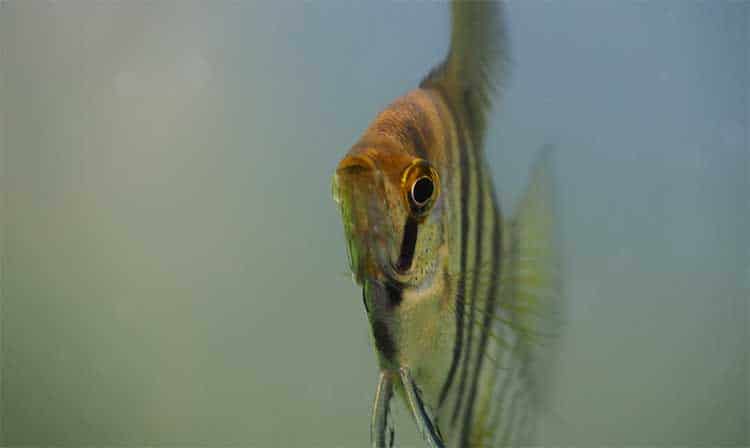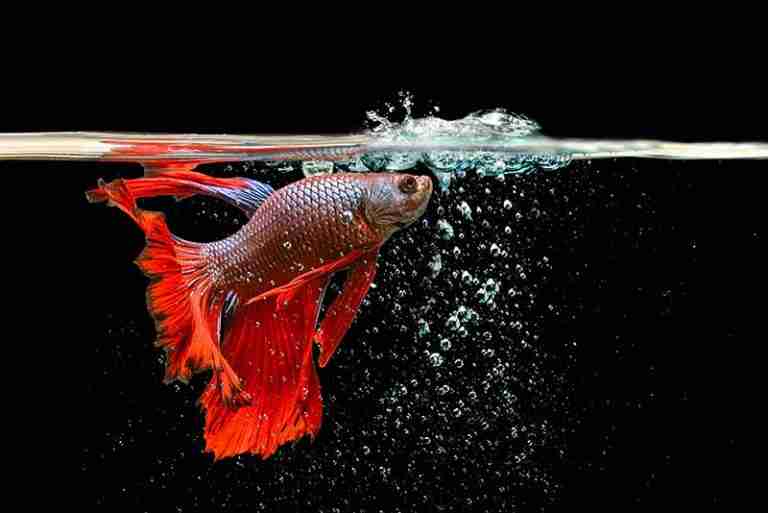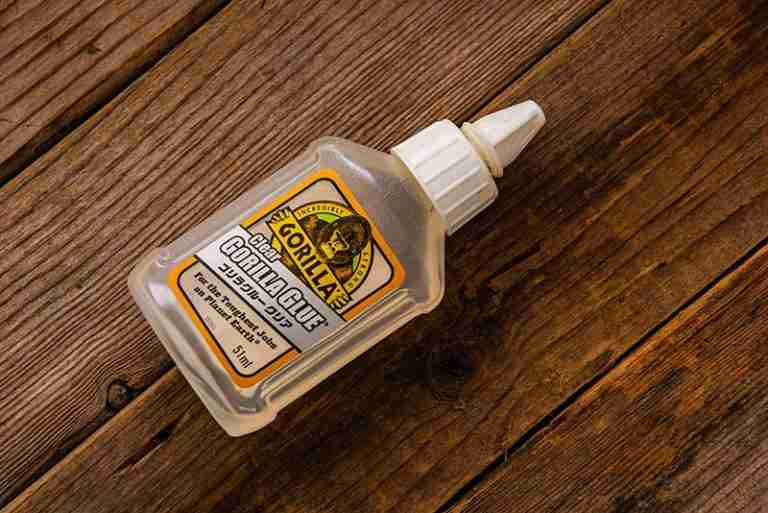How To Clean Aquarium Plants (of dirt, pests, and algae)
If you have a planted tank, you may not realize that cleaning aquarium plants is just as important as cleaning the rest of your aquarium. Plants become dirty, and algae overgrowth suffocates the fish in your tank while clinging to your plants, slowly strangling and robbing them of the nutrients they require to remain healthy.
If you have ever tried to clean an aquarium plant, it can be a frustrating experience. The plants tend to float away, and they are so delicate that dirt and debris seem impossible to remove.
In this article, you will learn how to clean aquarium plants easily, using several methods I use myself, removing dirt, pests, and algae that can cause problems for your fish.
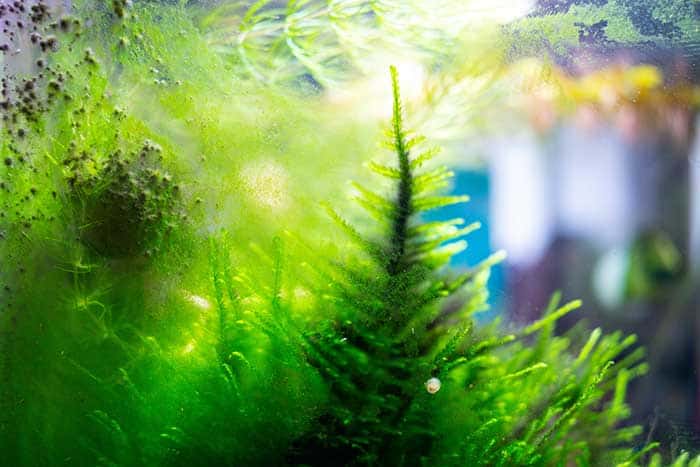
Cleaning live aquarium plants is a delicate process that needs to be planned. Ensure you have the correct chemicals and tools to complete the cleaning process effectively.
The basic aquarium plant cleaning steps are:
- Always try to clean live plants without removing them. Plants develop delicate root systems that can easily become damaged. Using a gentle brush or an aquarium-safe algae pad, you can remove small amounts of dirt, debris, and algae by gently brushing the top and underside of the leaves.
- If your aquatic plant leaves are small and delicate, or the debris is more stubborn, you must remove them carefully without damaging the roots. If your plants are attached to rocks, wood, or ornaments, remove them with the plant attached.
- Try rinsing the plant under warm (gentle) running water. If you use a sink, plug the drain so the plant doesn’t float away. Try more gentle scrubbing to free any dirt or debris from the plant.
- Prepare a chemical dip made up of white vinegar or bleach. Yes, you can clean plants with bleach, vinegar, and other chemicals, and you can find out how to prepare these dips later in this article.
- Dip your plants in the bleach solution for up to 5 minutes but don’t submerge the roots in the dip as they are too delicate. Most plants can tolerate up to 15 minutes in a vinegar solution.
- Remove the plants and immediately rub the leaves again or rinse under a tap. Stubborn debris and algae should now be easier to remove.
- Quickly place the plant into a bucket of warm dechlorinated water for 10-15 minutes to remove any bleach residue or other chemicals and neutralize its effects.
- Carefully return your plants to the tank in their original position.
By following these simple steps, you can keep your aquarium plants looking beautiful and healthy.
Aquarium plants like Java Moss may not be easy to clean, especially if they are carpeted in your tank, as they are impossible to remove. If you have let it grow around rocks or wood, it can be removed while still attached.
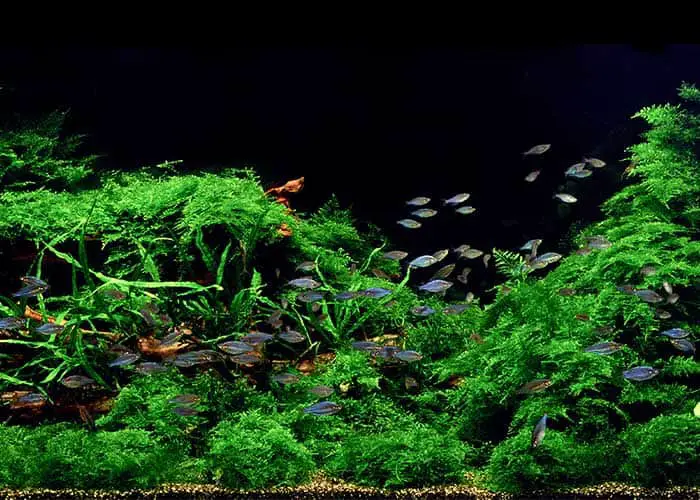
Java Moss can be cleaned using a gravel vacuum. Gently pressing it into the moss often releases built-up dirt quite quickly.
Important
Not all plants can withstand chemical dips the same way, so I would advise you to check if your particular plant species has any specific advice against using chemicals on it. Hardy plants can withstand extended dips, whereas delicate plants will only tolerate quick dips.
The rest of this article tackles a few of the more specific cleaning requirements around aquarium plants. It will cover each process thoroughly and discuss the equipment you need. If chemicals are required, I also explain which chemicals are best to use with the correct mixing ratios to avoid damaging your plants.
How Often To Clean Aquarium Plants?
If you have live plants in your aquarium, you might be wondering how often you need to clean them. This depends on a few factors, including the type of plants you have, the size of your aquarium, and the number of fish.
Typically you should clean your live plants once every one or two weeks as part of your regular cleaning schedule. This helps remove any algae or other debris before it attaches too firmly.
Large aquariums are not usually so heavily stocked, so you may not need to clean your plants as frequently. You can also buy particular algae-eating fish that can help to keep your plants clean.
Whatever approach you choose, keep an eye on your plants and clean them as needed to ensure they stay healthy and beautiful.
How To Clean Algae Off Aquarium Plants
Green fish tank water is caused by algae overgrowth, which is a common problem in aquariums. Excess algae can cause cloudy fish tank water and may hurt water quality, quickly taking over if left unchecked. Algae formation can happen throughout the tank, attaching to the aquarium glass, rocks, and decorations, and can sometimes cover an entire plant.
There are several different types of algae, all of which can be unsightly and create havoc with your water conditions. For instance, algae can be a real drain on water oxygen levels.
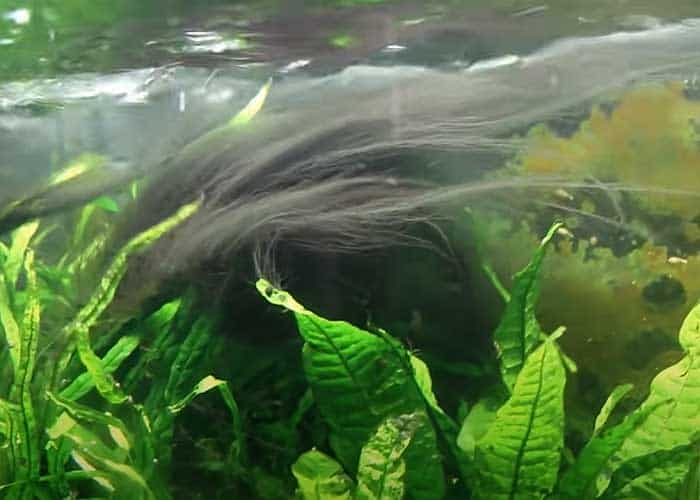
A sudden increase in algae can be caused by many factors and usually starts with an algae bloom closely followed by a bacterial bloom. The bacterial bloom is formed because of beneficial bacteria, which feed on the algae until it is under control.
The best method for cleaning algae from your plants is to remove it by hand or use an algae pad to rub it away gently.
If you have a lot of algae and it has attached deep within your aquarium plant’s leaves and branches, a 5% bleach dip will kill the algae in only a few minutes.
After dipping in the bleach solution, dead algae changes color and gradually drops off by itself, or your fish may feed on it until it is gone.
If your plant is too delicate for a bleach dip or hydrogen peroxide dip, it may tolerate a vinegar dip. Vinegar is slightly less effective at killing algae but still a good alternative.
Chemical dips should always be considered a last resort for cleaning plants, and there are far better ways to keep algae at bay.
Algae eaters such as Plecos, Nerite snails, and Siamese Algae Eaters will help keep algae levels under control. Simple and regular tank maintenance will also keep algae from building until it is too difficult to clean by hand.
Certain tank conditions promote algae growth and should be avoided.
Conditions that can increase algae growth are:
- Prolonged light exposure – More than 10 hours of light can cause excessive algae growth.
- Excess food and fish waste – Algae feeds on ammonia, nitrate, and phosphates created by rotting food and fish waste.
- Warmth – Extra hours of daylight often come with warmer temperatures. Because algae is a plant, the increase in light and warmer temperatures aid photosynthesis, the method that aids plant growth and promotes algae blooms to occur.
- High pH levels – As pH levels increase in your tank, so will the likelihood of algae growth. Algae thrive at a pH level of between 8 and 8.7. Most fish will do fine at a more neutral pH between 6.7 and 7.5.
- Poor water circulation – A weak filtration system can cause your fish tank to become stagnant, which helps algae to bloom. Poor filtration also allows water conditions to drop, creating the perfect environment for algae to grow.
I found the below video on Youtube, which describes how to deal with algae build-up on your aquarium plants using a bleach solution.
How To Clean Algae Off Fake Aquarium Plants
Cleaning algae off fake aquarium plants is more straightforward than cleaning live plants. Artificial plants are much more robust and won’t break when removing them from the fish tank or when scrubbing them.
Vigorously scrubbing your fake plants with a medium-strength brush should be enough to dislodge any algae that cannot be removed by hand. A final rinse under moderately hot water will remove any remaining algae.
I would avoid dipping fake plants into bleach as it may take away some of the colors and is not necessary.
How To Clean Aquarium Plants Of Snails
Snails are a common pest in aquariums, and they can rapidly multiply under the right conditions. Plants are the perfect food source, and large numbers of snails can cause real damage to your treasured plants.
There are several ways to remove pest snails from aquarium plants, such as using aquarium salt or an aquarium salt dip. Salt kills existing snails and snail eggs, which are often unseen as they are hiding under the plant leaves. Fish like clown loaches are also good at keeping snail populations down.
How To Remove Snails From Aquatic Plants
The simplest method of removing snails from aquarium plants is by hand. Snails can be picked off by hand or brushed off if you only have a few snails.
Another popular method for removing snails from plants is using a salt dip. Aquarium salt or kosher salt is the best choice for aquatic plants as other salts may contain harmful chemicals that are unsuitable for plants.
A salt dip doesn’t need to be too strong. It reacts with the slime on the snail’s body, causing an instantaneous dehydrating effect that quickly kills the snail.
The ideal ratio is approximately 1 cup of salt per 1 gallon of distilled water when mixing your salt dip. You need to stir the salt in and allow it to sit while the salt dissolves into the water before dipping your plants for around 5 minutes.
Never dip the plant roots into the salt dip, as the salt absorbs quickly and causes the roots to rot.
Rinse your plants thoroughly in fresh distilled water when finished, and this should help wash any remaining snails off.
How To Remove Snail Eggs On Aquarium Plants
Removing snails from plants by hand is not too difficult as they are usually relatively easy to see. However, their eggs can be a little more difficult to spot.
Snail eggs are often found on the underside of plant leaves or on stems and are usually clusters of small white dots.
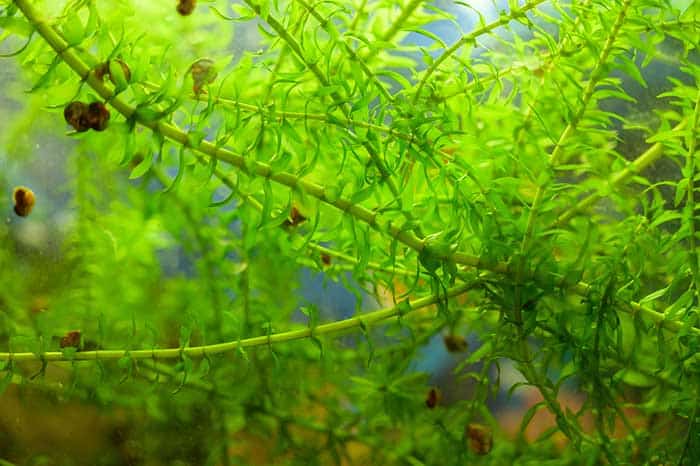
Salt dips, as described above, are an effective method for killing snail eggs as well. You can also remove snail eggs by gently scrubbing the plant leaves with a soft toothbrush.
Once you have removed all the snail eggs, it is essential to rinse the plants thoroughly in fresh water to remove any residual salt which could harm your plants.
How To Quarantine Aquarium Plants
Quarantining aquarium plants may be required for new plants or plants exposed to snail infestations, parasitic infections, and harmful diseases.
When you have parasites and diseases prevalent in your tank, most medications will effectively treat the entire tank, including your plants. Still, you may need to remove and quarantine both fish and plants for further treatment in some circumstances.
I recommend quarantining new plants in a separate tank for at least 2 weeks to allow any pests or diseases to show themselves. This will give you time to treat the plants before adding them to your main aquarium.
Quarantining aquarium plants is relatively simple and can be done in a separate container filled with water from your aquarium.
You need to add an air stone to provide aeration, and adding a small amount of aquarium salt to the water can be beneficial.
Treating specific diseases or parasites can be done while in quarantine without affecting the health of fish or plants in the main tank. The plants can then be left for 2 weeks and checked daily for any signs of pests or disease.
How To Disinfect Aquarium Plants
Several chemicals can be used to disinfect aquarium plants. Effective disinfection will make your aquatic plants safe to add to your main aquarium without the risk of introducing hidden bacteria and parasites which can spread through your fish tank.
The three most commonly used chemicals used to disinfect aquarium plants are:
- Potassium Permanganate
- Hydrogen Peroxide
- Bleach
Below I have explained the correct methods for mixing and dipping using these chemicals.
Cleaning Aquarium Plants With Potassium Permanganate
Potassium Permanganate is a commonly used disinfectant among aquarists. Although Potassium Permanganate is a potent oxidizing agent, it is generally considered safe to be used with most aquatic plants.
Potassium Permanganate can be purchased in liquid or crystal form and should be added to half a bucket of clean, warm water.
Mix approximately 4mg of crystals per liter of water until you get a nice dark pink or purple color. If you use the liquid solution, you may need to add twice as much to achieve the same.
Plants should be dipped for 10 minutes (15 minutes maximum) before removing and immediately rinsing them in a suitable, ready-prepared neutralizing rinse.
How To Clean Aquarium Plants With Hydrogen Peroxide
Hydrogen peroxide is another strong oxidizing agent commonly used for bleaching and as an antiseptic treatment.
A hydrogen peroxide plant dip should contain around 3% hydrogen peroxide, which works out to about 3ml per gallon of water.
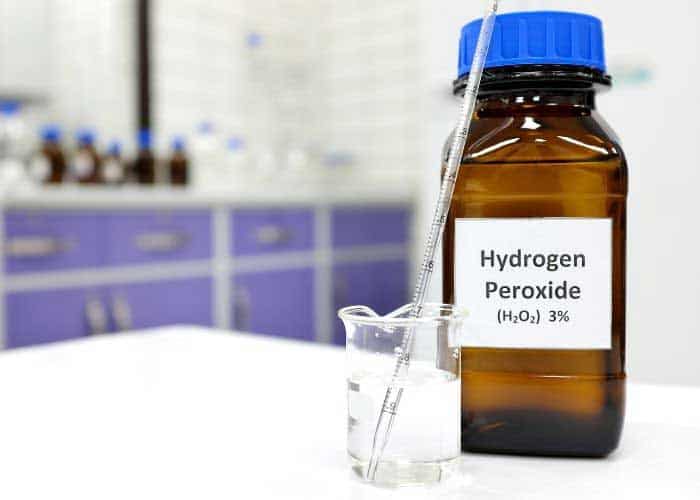
Plants should only be dipped for up to 5 minutes for aggressive cleaning of snail eggs and algae or only 1-2 minutes for general disinfection.
After dipping, plants should be rinsed thoroughly in a strong neutralizing rinse made with a concentrated dechlorinator.
How To Clean Aquarium Plants With Bleach
Bleach (sodium hypochlorite) is commonly found in most households and is an excellent disinfectant and antimicrobial agent.
Like Potassium Permanganate and Hydrogen Peroxide, bleach is another strong oxidizing agent and should be mixed in a much smaller ratio.
The recommended ratio for a bleach plant dip is 1:19 or 1 part bleach to 19 parts water.
Once your bleach dip has been prepared, you should dip your plant for up to 5 minutes for aggressive cleaning or only 1 minute for general disinfection and sterilizing.
Rinse immediately in a strong neutralizing dip of water mixed with a concentrated dechlorinator.
Warning
1. Chemical dips have the potential to harm plants if not done correctly. Delicate roots should never come into contact with chemicals and you should always rinse with a strong neutralizing agent after dipping.
2. Always take precautions and wear safety equipment when using chemicals.
3. Never mix chemicals together as they may become unstable or release noxious, poisonous gasses.
Should You Quarantine New Aquarium Plants?
It is highly recommended that you quarantine new aquarium plants before adding them to your aquarium. Quarantining new aquarium plants can be an essential step, which I would advise everyone to take as it will help avoid introducing new pests or diseases into your tank.
Pests such as snails or algae can easily hitch a ride on new plants and quickly multiply in your aquarium if not caught early.
Disease-causing bacteria and parasites can also attach to plants and can be devastating to your fish if not treated quickly.
After introducing new plants to your tank, if you suddenly notice your fish rubbing on rocks, gravel, or other objects in your tank, it is likely they have picked up some parasites that they are trying to shake off. At this point, it’s too late to quarantine your new plants, so you need to seek a proper diagnosis and start treatment as quickly as possible.
How To Clean Aquarium Plants Before Planting
Cleaning new aquarium plants before planting is a simple process. Although I have already recommended that you sterilize new plants to avoid the risks of introducing new diseases or pests into your aquarium, you should also give the plants a good rinse under running water to remove any dirt or debris which may have become attached during transit.
Warm running water is enough to remove most debris, including loosely attached algae, and you can also use a new algae pad or soft-bristled toothbrush to remove any stubborn algae growth.
Once your plants have been given a good rinse, you can then dip them in a sterilizing solution as described above for good measure.
After sterilizing, it is important to give the plants a final rinse in clean water before planting them in your aquarium.
Once you have given the plants a good rinse, you can plant them in your aquarium.
How To Clean Live Aquarium Plants With Vinegar
Vinegar is also commonly used as a sterilizing plant dip and is far less damaging to delicate plants. Most plants can tolerate a vinegar dip for up to 15 minutes without any adverse effects, and vinegar is acidic enough to kill or repel most live organisms.
Although white vinegar is a popular choice, any vinegar with an acetic acid concentration of 5-10% will do.
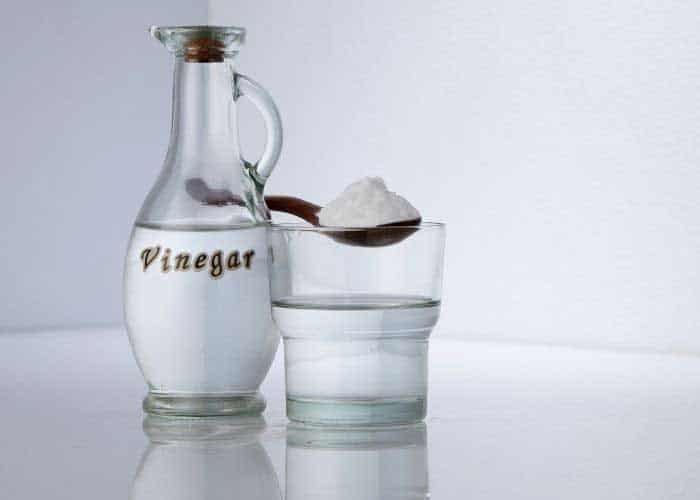
To make a vinegar dip for aquarium plants, mix half a cup of vinegar with half a gallon of warm and mix in a bowl.
Dip your plants (not roots) into the mix for up to 15 minutes and rinse thoroughly in a bowl of clean, dechlorinated water to remove any vinegar residue.
Gentle scrubbing with a soft brush will help remove any tough algae; however, it shouldn’t take long to drop off by itself.
Vinegar is not only good at cleaning and sterilizing plants, but it is also a good general cleaner that you can use to clean your entire tank. You can find out how in my article: How To Clean A Fish Tank With Vinegar (In 9 easy steps).
How To Clean Plastic Aquarium Plants
Plastic aquarium plants are much easier to clean than live aquarium plants because they cannot be killed.
Artificial plants don’t attract living organisms such as parasites and snails in the same way live plants do because they cannot be fed on.
Plastic plants can also be scrubbed much harder and tolerate most chemical dips, but I would avoid bleach solutions as they can sometimes make colors fade.
Quarantining artificial plants is not necessary, and a simple vinegar dip (which I have described in the previous section) is all that’s necessary, with some vigorous scrubbing to remove any build-up of dirt and debris.
How To Clean Silk Aquarium Plants
Silk aquarium plants can be beautifully colored and more delicate than standard plastic artificial plants, so you should be a little more cautious when cleaning them.
Silk plants can tolerate hot water, but you need to be careful of plastic which can melt. Hot (not boiling) water kills most living organisms and is excellent at loosening dirt, debris, and tough algae deposits.
A strong vinegar dip of 1 cup vinegar to half a gallon of water won’t harm silk plants, and they can be left to soak for 30 minutes. You can also use a cotton ball to brush vinegar over the leaves by hand.
Wrap Up
I hope this article has highlighted the importance of cleaning and quarantining aquarium plants. Many people are aware of the risks when introducing new fish into an established tank but fall short of their knowledge of plants and even substrates.
Live plants can be home to many harmful bacteria or parasites that can be very difficult to treat once they spread through your aquarium, so cleaning and disinfecting new plants should be an essential part of your routine.
Quarantining new plants or existing plants that you suspect to be infected helps to keep your existing fish healthy while you can inspect them for diseases.
Artificial plants do not carry the same risk potential and are easier to clean, but artificial plants also provide no benefit to the biological cycle of your tank.
You should always clean your plants gently, especially the roots, and avoid chemical dips as much as possible. The risks tend to outweigh the benefits of using chemicals, but regular dipping should be avoided.


